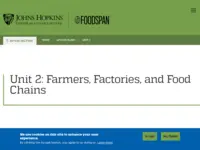Farmers, Factories, and Food Chains
https://foodspan.org/lesson-plans/unit-2-farmers-factories-and-food-chains
https://foodspan.org/lesson-plans/unit-2-farmers-factories-and-food-chains
Johns Hopkins Center for a Livable Future
This unit provides a comprehensive overview of the food system in the United States. It includes a combination of life and social science to introduce students to a full view of how food gets from where it starts to their plates. Students will explore how crops are grown in industrial agriculture and how those practices impact human health and ecosystems. This lesson also covers the importance of soil, freshwater, and biodiversity in agriculture.
This learning activity takes nine 50 minute class periods.
Learn more about Teaching Climate Literacy and Energy Awareness»Grade Level
Regional Focus
Online Readiness
Topics
Climate Literacy
This Activity builds on the following concepts of Climate Literacy.
Click a topic below for supporting information, teaching ideas, and sample activities.
Notes From Our Reviewers
The CLEAN collection is hand-picked and rigorously reviewed for scientific accuracy and classroom effectiveness.
Read what our review team had to say about this resource below or learn more about
how CLEAN reviews teaching materials
Teaching Tips | Science | Pedagogy |
Technical Details
Teaching Tips
- Each lesson builds on the previous one, however classrooms that have previously covered some topics may be able to use the lessons as stand-alone curriculums. This unit covers the majority of lessons (9 of the 17) in the larger lesson set. It may be helpful to have students start with lessons A and B if they are not already somewhat familiar with the topic.
- Consider using some or all of the lessons in this curriculum, and offering the option to choose one activity extension. Students can then lead the class in a brief presentation and discussion about their chosen activity extension.
- The graphic in the full lesson set overview is helpful for considering whether it will be most useful for you to focus on individual lessons, this unit, or all three units. It may also help teachers in different subjects coordinate if you choose to co-teach this lesson set.
About the Content
- This resource provides a collection of 9 lessons to help students understand the connection between farming, health, society, and the environment.
- Students will examine conventional industrial practices, explore sustainable alternatives, and consider the impact both have on human health and the environment.
- Each lesson builds on the others by first establishing a personal connection between students and the food system, and then providing context for the specific lesson.
- Students will engage with a variety of content in the form of infographics, background reading, short classroom activities, and thoughtful discussion-based activities to hone critical thinking skills.
- This resource does not use any datasets or models and instead supports a social-studies based understanding of climate content, critical thinking, and investigation. Each activity provides an extension activity in the form of reading or a video.
- Passed initial science review - expert science review pending.
About the Pedagogy
- Students will use mainly infographics and background reading to support classroom discussion and self-reflection.
- Small interactive classroom activities are also used to demonstrate concepts like interconnectedness.
- Teaching objectives are clearly stated for each lesson, and students will learn to utilize observation and investigation skills as they reflect on their own impact and effects of the food industrial system in their lives.
Technical Details/Ease of Use
- The lesson plan with handouts and slides link appears to be broken, however the content is accessible through the individual lesson links.
- There is some prep involved for teachers to have the cards ready if you choose to teach those lessons.








